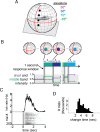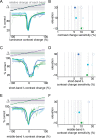Mouse color and wavelength-specific luminance contrast sensitivity are non-uniform across visual space
- PMID: 29319502
- PMCID: PMC5762155
- DOI: 10.7554/eLife.31209
Mouse color and wavelength-specific luminance contrast sensitivity are non-uniform across visual space
Abstract
Mammalian visual behaviors, as well as responses in the neural systems underlying these behaviors, are driven by luminance and color contrast. With constantly improving tools for measuring activity in cell-type-specific populations in the mouse during visual behavior, it is important to define the extent of luminance and color information that is behaviorally accessible to the mouse. A non-uniform distribution of cone opsins in the mouse retina potentially complicates both luminance and color sensitivity; opposing gradients of short (UV-shifted) and middle (blue/green) cone opsins suggest that color discrimination and wavelength-specific luminance contrast sensitivity may differ with retinotopic location. Here we ask how well mice can discriminate color and wavelength-specific luminance changes across visuotopic space. We found that mice were able to discriminate color and were able to do so more broadly across visuotopic space than expected from the cone-opsin distribution. We also found wavelength-band-specific differences in luminance sensitivity.
Keywords: color; luminance; mouse; neuroscience; psychophysics; retinotopy; vision.
Conflict of interest statement
No competing interests declared.
Figures






References
-
- Applebury ML, Antoch MP, Baxter LC, Chun LL, Falk JD, Farhangfar F, Kage K, Krzystolik MG, Lyass LA, Robbins JT. The murine cone photoreceptor: a single cone type expresses both S and M opsins with retinal spatial patterning. Neuron. 2000;27:513–523. - PubMed
-
- Baker M. Through the eyes of a mouse. Nature. 2013;502:156–158. - PubMed
Publication types
MeSH terms
LinkOut - more resources
Full Text Sources
Other Literature Sources

